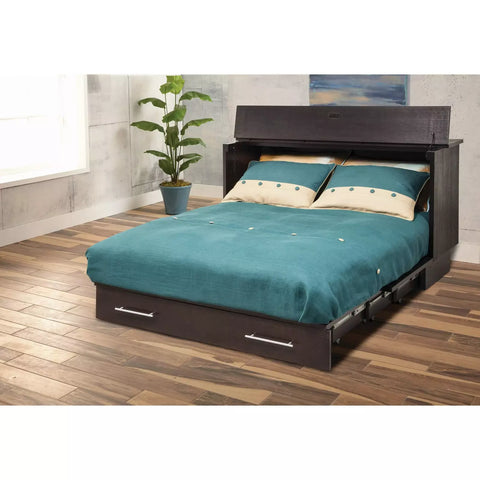
Who Invented Folding Cabinet Bed: (Uncovering the Origins)
In the world of furniture design, the invention of the folding cabinet bed was a game changer. This space-saving piece of furniture traces its origins back to the late 19th century when innovative minds sought creative solutions to make urban living more convenient. The folding cabinet bed is an incredible invention that not only served its purpose as a comfortable bed but also doubled as a functional storage cabinet, making it a perfect addition to small homes and apartments.

Sarah E. Goode, a former enslaved person turned entrepreneur, was the inventor of the folding cabinet bed. Born in 1855 in Toledo, Ohio, Goode would eventually become one of the first African American women to be granted a patent by the U.S. Patent and Trademark Office (Biography) . After gaining her freedom, she moved to Chicago and opened a furniture store with her husband, Archibald Goode. Drawing inspiration from the challenges faced by urban dwellers with limited living spaces, Goode created and received a patent for the folding cabinet bed in 1885 (Hunker).
This remarkable piece of furniture consisted of a bed that would fold up into a cabinet when not in use, hiding the bed and freeing up floor space. Goode's clever invention received Patent #322,177 on July 14, 1885 (ThoughtCo). Her lasting contribution to innovative furniture design continues to inspire modern space-saving solutions and stands as a testament to her resourceful spirit.
The Inventor: Sarah E. Goode

Sarah E. Goode was a trailblazing inventor and entrepreneur. Born in 1855 in Toledo, Ohio, Goode was one of the first African American women to receive a United States patent1.
Her groundbreaking invention, the Folding Cabinet Bed, was granted patent number 322,177 on July 14, 18852. This invention was designed to make the most efficient use of small living spaces and later evolved into the modern-day Murphy bed3.
As a businesswoman, Goode owned a furniture store in Chicago where she focused on catering to the needs of her customers. The cabinet bed was designed as a response to the demand for space-saving furniture in the city. Some notable features of the folding cabinet bed included:
- Hinged sections, allowing for easy transition between bed and cabinet4
- A compact design that occupied minimal floor space when not in use5
- Dual functionality, providing both a bed to sleep on and a cabinet to store personal items6
Goode's inventive spirit and determination paved the way for future inventors and entrepreneurs, particularly African American women. Her folding cabinet bed remains a testament to her ingenuity and influence in the field of design and engineering.
The Folding Cabinet Bed
The folding cabinet bed, a space-saving invention, was created by Sarah E. Goode in 1884. As a furniture store owner in Chicago, Goode recognized the need for multifunctional furniture that could fit in small homes. In response to this need, she invented the folding cabinet bed which would transform from a desk into a bed when needed.
Design
The design of the folding cabinet bed consisted of the following features:
- A wooden cabinet that resembles a desk when folded
- A hidden mattress and bed frame within the cabinet
- Hinged sections that allow the bed to fold and unfold
- Storage compartments for bedding and other items
This innovative design allowed users to make the most of their limited living space by combining two essential pieces of furniture into one.
Functionality
The folding cabinet bed was designed for easy and quick transformation between its two functions. The process of converting the cabinet bed included:
- Opening the cabinet doors to reveal the hidden bed frame and mattress
- Folding down the hinged sections of the bed frame
- Unfolding the mattress and adjusting it onto the extended bed frame
When it was time to convert the bed back into a cabinet, the process was simply reversed. This practical and space-saving invention was a significant contribution to home furnishing, especially for those living in small or cramped spaces.
In 1885, Sarah E. Goode became the first African American woman to receive a U.S. patent for her folding cabinet bed. Through her invention, she demonstrated an innovative and practical solution to the challenges faced by many urban dwellers during her time. Today, Goode's invention remains an inspiration for modern furniture designers focusing on space-saving and multifunctional products.
Historical Context
African American Inventors in the Late 19th Century
In the late 19th century, African American inventors made significant contributions to various industries:
- Garrett Morgan invented the traffic signal and gas mask.
- Madam C.J. Walker developed hair care products for African American women.
- Elijah McCoy invented an automatic lubrication device improving efficiency of steam engines.
Among these notable inventors, Sarah E. Goode stands out as the first African American woman to receive a U.S. patent for her invention, the folding cabinet bed.
The Impact on Urban Living Spaces
The folding cabinet bed revolutionized the use of space in urban homes. During the late 19th century, urban areas experienced rapid growth, leading to increased population density and smaller living spaces. Goode's invention addressed these issues:
- Increased functionality: When not in use, the cabinet bed resembled a desk, making it suitable for multipurpose use in small areas.
- Space-saving design: The fold-up mechanism allowed for efficient use of limited floor space and easy storage.
- Affordability: This innovative bed provided an affordable solution for those living in cramped urban dwellings.
The folding cabinet bed not only demonstrated Goode's ingenuity but also made a lasting impact on the design and functionality of urban living spaces.
Patenting and Recognition
First African American Woman to Receive a U.S. Patent
Sarah E. Goode was a pioneer in the world of inventing, as she became one of the first African American women to receive a United States patent. Her groundbreaking invention, the folding cabinet bed, was designed to make efficient use of limited space in small living areas.
In 1885, Goode submitted her innovative idea for a folding cabinet bed, and on July 14 of that year, she was granted patent number 322,177 by the U.S. Patent and Trademark Office.
Goode's cabinet bed was a versatile piece of furniture that combined practicality and design. Its hinged sections could be easily raised or lowered, transforming between a comfortable bed and a functional cabinet.
The impact of Sarah Goode's invention went beyond its practical use. It signified a major breakthrough for African American women in the field of invention and showcased the valuable contributions of Black inventors to American society. Over the years, the folding cabinet bed has continued to evolve, and its modern-day version is known as the "hide-away bed."
Section 6: Legacy and Influence
Sarah E. Goode's invention of the folding cabinet bed has left a strong impact on the world of furniture design, specifically in space-saving solutions for urban living. Her innovation has inspired further inventions and adaptations to cater to different living spaces and modern requirements.
Modern Space-Saving Furniture Solutions
Explore Modern Cabinet Beds Here >>>
Goode's original invention has paved the way for numerous modern space-saving furniture solutions. Some popular examples include:
- Murphy beds: Also known as wall beds, these fold up into the wall when not in use, creating space for other purposes. Murphy beds are a direct descendant of Goode's original folding cabinet bed. (source)
- Convertible sofas: Sofas that transform into beds, providing dual functionality for urban dwellers where space is limited.
- Nesting furniture: Pieces such as nesting tables or chairs that can be stacked or tucked together to save space when not in use.
- Extendable tables: Dining tables with a mechanism to expand or contract, allowing for flexible seating arrangements depending on the number of guests.
- Foldaway desks: Desks that can be folded onto the wall when not in use, creating room for other activities.
In addition to these specific furniture solutions, Goode's innovative spirit has also inspired designers to prioritize multi-functionality and space optimization in general. With increasing urbanization and the growing trend of minimalist living, her legacy serves as a reminder of the potential for creative problem solving in the world of design.
Conclusion
In this article, we have explored the innovative invention of the folding cabinet bed, credited to African American inventor and entrepreneur, Sarah E. Goode. Born in 1850, Goode was an astute businesswoman who recognized the need for space-saving solutions in the small living spaces of urban families during the late 19th century.
Understanding the challenges faced by her community, Goode developed the folding cabinet bed as a practical, functional, and elegant response to the demands of her clientele. The folding cabinet bed not only provided a comfortable sleeping space but also a practical piece of furniture with compartments for stationery and writing supplies when folded up.
Today, the legacy of Sarah E. Goode's ingenuity is evident in the variety of space-saving furniture solutions found on the market. Her determination and inventive spirit have left a lasting impact on the industry and beyond.
In summary, the invention of the folding cabinet bed can be attributed to Sarah E. Goode, who received a patent for her design in 1885, making her the first African American woman to receive a US patent (We Sleep Well). This remarkable invention continues to inspire and influence modern furniture design.





